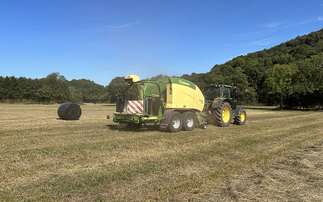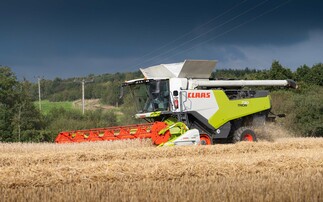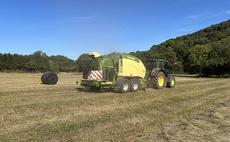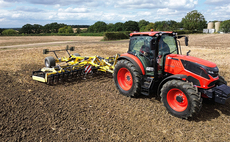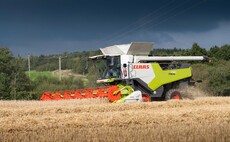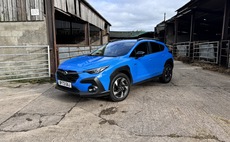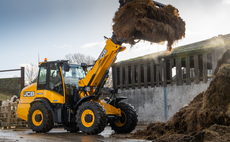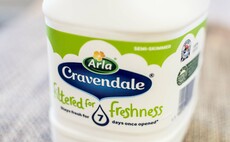
Complementing its existing models, Househam Sprayers has extended its self-propelled range with the introduction of the Predator.
Geoff Ashcroft took a closer look at this all-new flagship machine from the British maker.
When it came to the design of the all-new Predator, Househam Sprayers went back to the drawing board.
It started with an new chassis capable of making the most of the latest tyre technology. This means 380/90 R46 row crop tyres are a bolt-on fit without compromising stability or manoeuvrability, says the firm, delivering a longer contact patch and a higher 1.1-metre ground clearance than the firm's previous flagship, the Merlin.
The Predator is currently available with three stainless steel tanks offering 4,000, 5,000 and 6,000 litres. Each can be equipped with twin-fold or tri-fold steel booms from 24-36m.
While booms and tank sizes currently mirror those of the Merlin, the newer platform affords the desire to go bigger.
In addition, Predator offers a 50kph transmission, DAB audio system, dual rear-view cameras, in-cab cool box, 900 litres/minute centrifugal pump, load sensing hydraulics and a hydraulic trailer hitch with a three-tonne capacity for those looking to tow a bowser.
Househam product manager Toby Corsan says: "We have developed the Predator as a top-spec self-propelled with a very high level of standard specification, and a price tag which starts below £200,000 for a 4,000-litre/24m version.
"This simplifies the buying process and streamlines production. If we are not building bespoke models with individual specifications, we can reduce build times, increase our production and shorten delivery times."
"We have developed Predator so it treads lightly - it weighs about 10t un-laden," he says. "That means a generous reduction in ground pressure for a sprayer of this size and capacity."
Michelin is the only tyre choice available from the factory, and this example is using 650/60 R38 Michelin Xeobib tyres.
Spray Pack
- Spray Pack
At the rear, the boom is carried on a pantograph linkage in place of a mast, which is claimed to reduce weight and complexity. It also eliminates the need for up to 20 support rollers, which the firm does use on a tri-fold boom mast.
Standardising on specification means buyers will only need to choose a tank size and a boom width - everything else on a sprayer operator's wish list is included as part of the Predator's standard specification.
That spec extends to a host of kit including Househam's auto-nozzle select for individual nozzle control, using Altek's multi-nozzle bodies. Expect to find the Predator equipped with a full illumination package with nozzle pattern lighting, three-inch fast-fill, Norac boom levelling, adjustable track width from 72-84in and multi-mode steering.
Predator has ditched Househam's air ride suspension, in favour of a four-link mechanical system. The advantage here, says the firm, is a lighter and simpler construction - all links are identical and are interchangeable too. Hydraulic cylinders handle the suspension's self-levelling function, reacting to changes in load as the spray tank empties.
Boom pic
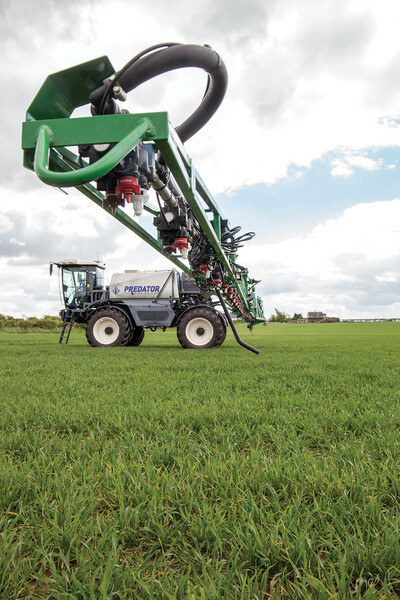
Powertrain
- Powertrain
Predator's component layout mimmicks the firm's smaller Spirit - the engine sits at the back, allowing the spray tank to be moved further forward, helping weight distribution.
The engine is a 230hp four-cylinder MTU power unit, and replaces the popular Caterpillar C6 engine which has been used elsewhere in the Househam range.
Mr Corsan says: "Mounting the engine in a transverse position helps with weight distribution and packaging, so a six cylinder was ruled out for its length. With several hydraulic pumps on the engine tailshaft, the sprayer would have been too wide. So the shorter four-pot MTU engine fits the bill, and it is also lighter than an equivalent six-cylinder too."
The twin-turbo MTU 4R 1000 engine meets EU Stage IV emissions compliance using an exhaust after-treatment fluid. The after-treatment package sits forward of the engine in a central position, allowing the stainless steel spray tank to wrap around it. This does mean engine access is challenging, but canbus communication allows remote checking of fluid levels from the cab.
Canbus also provides an exhaust brake and transmission braking function which has been developed to prevent engine over-speeding when travelling down steep banks.
A 300-litre fuel tank, accessed from the cab steps, and 40-litre DEF tank, located beneath the right-hand front corner of the cab, are said to have enough capacity for a long day's work.
Sprayer pic

Operation
- Operation
Househam's transmission uses the same components as found in the Merlin and the firm's Househam Intelligent Transmission System (HITS) makes the Predator an easy machine to control.
HITS delivers automatic modulation of acceleration and deceleration to prevent operators asking too much when it comes to speed changes. This gives the spray pack's rate control and regulation system time to respond when slowing down to make a headland turn, or when turning into a tramline and resuming the chosen spraying speed.
There are three work modes -- Normal, Power and Eco - plus Road and Field modes for travel speed selection. A fully adjustable two-speed cruise control function allows the joystick controller to be pushed fully forward in its gate, with the operator simply thumbing the cruise control buttons to switch between spraying and headland turn speeds.
Engine rpm is harmonised with machine functionality, allowing the MTU power unit to run at the lowest possible engine revs to provide just enough power to perform.
It can also run the hydraulically-driven, centrifugal pump at full capacity with the engine operating at tick-over.
A Hill Assist feature automatically applies the brakes when the sprayer stops. The brakes automatically release when you make a deliberate effort to drive away.
Controls pic
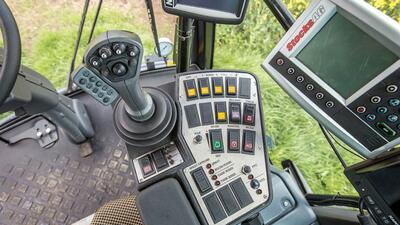
Cab
- Cab
When it comes to cab comfort, the engine's rear-mounted location gets a thumbs up for removing noise and heat from the operating environment. The Excalibur cab is a light and spacious platform with a premium feel and Category 4 cab filtration.
Mr Corsan says: "Customer expectations are high at this level of sprayer and we wanted the Predator's cab to deliver a superior feel with a higher quality finish."
Rear windows are tinted, and the front screen contains fine heating elements to speed-up demisting on misty autumn and winter mornings.
Multiple steering modes are accompanied by a hillside steering function which offers the capability to ‘nudge' the rear axle steering, to keep the back end of the sprayer on the upper side of a tramline.
The steering system affords an adaptive function which automatically toggles between two- and four-wheel steering, when the field mode is selected. This system responds to steering inputs but also prevents the back end of the sprayer from twitching when travelling across tramlines. A large amount of steering wheel movement automatically activates four-wheel steering; smaller inputs only steer the front wheels, allowing the rear axle auto-lock in its central position when the steering angle is within +/- 10 degrees of centre.
Visibility is impressive, controllability is good and the powertrain integration is likely to win over followers of big engines when it comes to performance. And the cab is now so quiet, the air conditioning fan is now among the noisiest aspects of the operating experience.
Cab pic
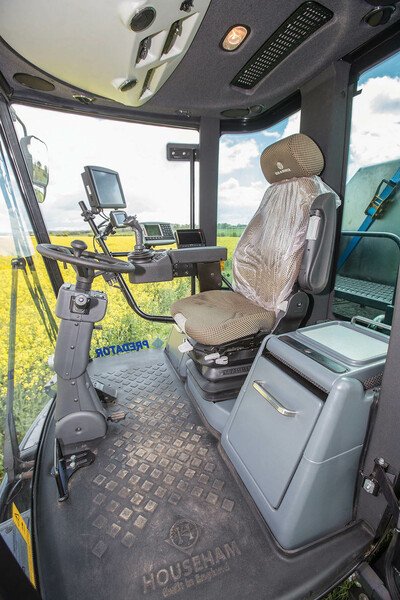
Verdict
Househam's Predator is very much a premium-spec machine with a high level of standard kit which should appeal to the most tech-savvy operators.
Its arrival hints that Househam is ready to shake-off its entry-level ethos and chase after a market sector which it has been missing by a country mile.
But is it enough to help the British maker muscle into a high-capacity, high-efficiency sprayer sector?
It does ride well and it delivers with cab comfort too, but only time will tell if potential purchasers are happy to ditch a six-pot in favour of a 230hp MTU four-cylinder. Fuel-saving, load-sensing hydraulics should help.










